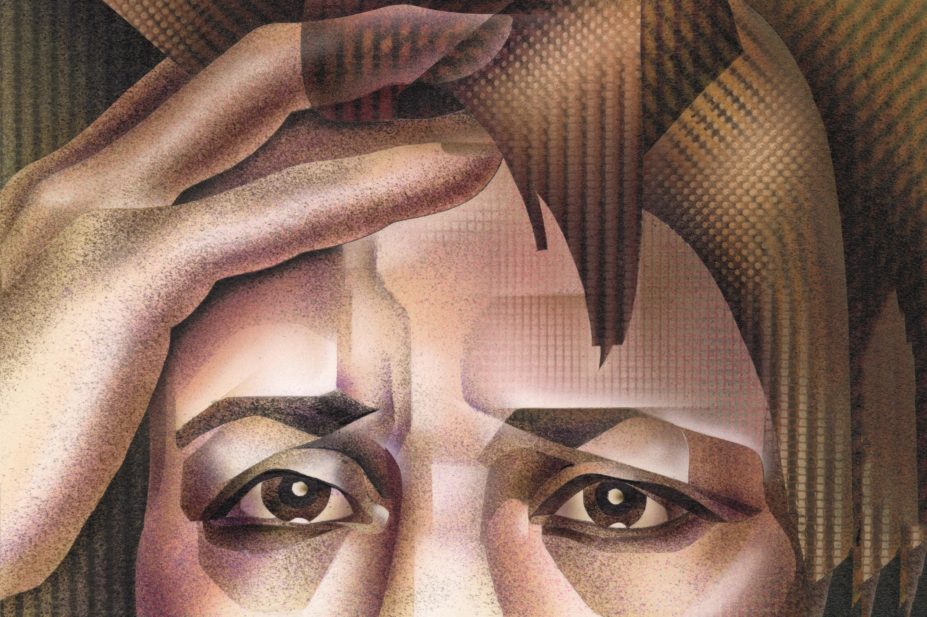
Illustration Works / Alamy Stock Photo
Your heart pounds and your mind races, adrenaline is pumped through every part of your body. Fear in the face of danger puts our bodies on high alert, helping us to dodge an oncoming car or quicken our step when walking alone at night. But for some, fear is enmeshed into everyday life, causing a variety of anxiety disorders with physical symptoms such as nausea, headaches, difficulty sleeping and panic attacks, as well as psychological symptoms including restlessness, paranoia and rumination.
Anxiety can also have knock-on effects on general overall health, increasing the risk of heart disease, high blood pressure, immune disorders, migraine, cancer progression, and metabolic disorders such as diabetes[1]
.
“The impact of stress on mental function is caused by the release of neurotransmitters, the fight or flight response. These all stress the body, which predisposes [it] to other conditions, including autoimmune disease,” says Craig Shimasaki, president and chief executive of Moleculera Labs, an autoimmune neurobiology testing company based in Oklahoma City.
When the fight or flight response is triggered repeatedly by the stresses of modern life, it can become “maladaptive” in some individuals, leading to chronic anxiety disorders (see ‘Panel: Classification of anxiety disorders’) or post-traumatic stress disorder (PTSD)[2]
. These conditions are disabling, shattering people’s social lives, their ability to work and putting strain on families, while placing a major financial burden on society and healthcare systems[3]
.
In 2013, there were around 8.2 million cases of anxiety in the UK, and women were around twice as likely to suffer from the condition as men. Anxiety affects people of all ages, with up to one in six young people having a form of anxiety disorder at some point in their lives. Despite a lack of understanding of the basic neurobiology behind anxiety disorders, there are several promising treatment strategies in development. However, existing treatments are not effective for all patients and are associated with significant side effects.
Unmet need
The existing treatments for anxiety include benzodiazepines and selective serotonin reuptake inhibitors (SSRIs), but neither of these medicines were created for this indication. The first benzodiazepine — chlordiazepoxide — was a serendipitous discovery in the New Jersey-based laboratories of Hoffmann-La Roche in 1955, and was launched throughout the world as the tranquiliser Librium in 1960[1]
. Benzodiazepines work by enhancing the effects of the inhibitory neurotransmitter gamma aminobutyric acid (GABA)-A in the brain. SSRIs, which increase levels of the neurotransmitter serotonin, were rationally designed as antidepressants, and the indications later broadened to several psychiatric disorders, including anxiety[4]
.
Benzodiazepines and SSRIs are low cost and widely available. However, while benzodiazepines are effective in acute treatment of generalised anxiety disorder and social anxiety disorder, they have limited impact in panic disorder and little or no effectiveness in other types of anxiety disorders. They are also ineffective in PTSD treatment and prevention, with the risks outweighing the short-term benefits[5]
. SSRIs are only partially effective in PTSD, generalised anxiety disorder and social anxiety disorder[3],[6]
and their effects can take a few weeks to kick in. Both benzodiazepines and SSRIs have side effects that have to be balanced against any benefits.
These factors together create a large unmet need for new anxiety drugs but, despite this, the number of drugs in the pipeline has fallen dramatically compared with 10 or 20 years ago, with many failing on efficacy grounds, according to Guy Griebel, director, evaluation and valorisation at Paris-based pharmaceutical company Sanofi. There are several reasons behind this R&D slowdown. One is the efficacy and cost effectiveness of existing drugs, meaning that new drugs have to get over high hurdles for approval and market access. Another is the complexity and heterogeneity of psychiatric disorders, which are influenced by both genetics and the environment.
“There may be a number of subtypes of different psychiatric disorders with different biology and genetics. This could explain different patient responses,” says Andrew Holmes, principal investigator at the laboratory of behavioral and genomic neuroscience, National Institute on Alcohol Abuse and Alcoholism, based in Rockville, Maryland.

Source: Courtesy of Andrew Holmes
Research into anxiety disorders must go back to basics and look at the neurobiology, says Andrew Holmes, principal investigator at the laboratory of behavioral and genomic neuroscience, National Institute on Alcohol Abuse and Alcoholism
For example, it’s not yet clear why some people develop stress disorders and others don’t, says James Giordano, a neurologist at Georgetown University Medical Center, Washington. “Stress can affect people in different ways, with biology, as well as social and cultural factors, all playing a role,” he explains.
Stress can affect people in different ways, with biology, as well as social and cultural factors, all playing a role
The lack of knowledge on the biology of anxiety disorders also provides a block to the development of anxiety drugs.
“By gaining better insights into the ways that the brain develops, and is influenced by and responds to environmental and interpersonal interactions, we may obtain a more finely grained view of what stress and anxiety are, how they affect different people in different ways,” says Giordano. “Brain science is using genetic, anatomical, and even cultural, studies to gain better insights to these variables, and to translate this understanding into improved clinical care.”
There has been disappointment in bench to bedside studies over the past 15 years, adds Holmes. “We need to go back to first principles, understanding the neurobiology, the pathways, and the circuits. When we understand which are the most important neurochemicals and understand their impact on the disease pathway, we can then design drugs to target activity with an aim to normalise function.”
Genetics and biomarkers
Work is underway to find out more about the genetics of anxiety disorders. “There are some exciting, but still tentative, developments in neurogenetics,” says Giordano. “These may allow improved targeting of brain pathways through the use of more selective drugs, or gene modification.”

Source: Courtesy of James Giordano
It’s still not clear why some people develop anxiety disorders and others don’t, says neurologist James Giordano at Georgetown University Medical Center
However, studies have found few candidate genes so far. Even if the genetic basis for anxiety disorders is discovered, there will still be the impact of environmental factors to take into account.
There have been many claims to finding the ‘anxiety gene’, but few of these are replicated
“There have been many claims to finding the ‘anxiety gene’, but few of these are replicated,” says Griebel.
Finding biomarkers that will categorise anxiety disorders more accurately, identify those more likely to respond to drugs, and that can be used as endpoints in clinical trials, could help to push therapeutic research forward.
“It’s hard to find clinical endpoints in these very complicated diseases in order to measure the benefits of the therapeutics,” says Holmes.
In some people, an abnormal response to stress leads to long-term psychological problems. A study of college students exposed to images of different faces, including fearful or angry ones, showed differences in threat-related amygdala reactivity that predicted psychological vulnerability to life stress occurring as much as one to four years later[2]
.
“While there was no specific link to the students’ current psychological profiles, there was a correlation with long-term tendency to higher anxiety. This could be seen as a potential biomarker, and a target for intervention,” says Holmes.
Pathways to innovation
Researchers are targeting a variety of different pathways to treat anxiety disorders, including the classic approaches, such as serotonin, GABA and monoamine oxidase, which plays a vital role in the inactivation of neurotransmitters. However, there are other, more novel, approaches in development that are showing potential.
Aloradine, a nasal spray-delivered agent, is a pherine that has a novel mechanism of action, stimulating nasal chemoreceptors on the vomeronasal organ. This transmits messages rapidly to the brain’s limbic system, amygdala and hypothalamus, directly modulating brain autonomic, psychophysiological, and neuroendocrine responses without systemic uptake and distribution. The dose is very small — 3.2μg— and the drug can be self-administered using a simple, low-cost device.
“Our initial clinical study of aloradine in people with generalised anxiety disorder showed rapid improvement in anxiety symptoms within ten minutes of treatment,” says Louis Monti, vice president of research at manufacturer Pherin Pharmaceuticals, based in Los Alto, California. “The safety profile was better than other anxiolytics, and no other intranasal anxiolytic shows such rapid onset.” The effects were significant within 30 minutes, and lasted for an hour[7]
.
“This lends itself to an ‘as needed’ dosing,” says Michael Liebowitz, a clinical psychiatrist at Columbia University and managing director at the Medical Research Network, a private clinical research site focusing on psychiatric, neurological, and chronic pain disorders, based in New York. “However, because the dose is low, the device is simple to use and the side effects are minimal, it could also be used in chronic conditions, such as generalised anxiety disorder.”
Pherin is now testing aloradine for social anxiety, an acute disorder, allowing outcomes to be measured more easily.
Several companies are looking to target the metabotropic glutamate receptors (mGluRs), which modulate signal transmission in the brain. London-based Gedeon Richter’s RHG 618, an mGluR1 and mGluR5 agonist, is in a phase I trial for anxiety, and Geneva-based Addex Therapeutics has an early stage molecule targeting the mGluR7 pathway, which produces anxiolytic effects in mice. However, the mGluR pathways have their challenges. Addex Therapeutics developed ADX71149, a positive allosteric modulator of mGluR2, for the treatment of anxiety but while early clinical trials showed some efficacy, it was not seen to be enough to warrant continued studies, and partner Janssen Pharmaceuticals is now positioning the molecule in epilepsy.
Researchers have also turned their attention to the endocannabinoid system, which is responsible for the mind-altering effects of cannabis. Endogenous levels of endocannabinoids have been linked with stress, fear and anxiety and, in animal models, blocking the serine hydrolase enzyme, fatty acid amide hydrolase (FAAH), or deleting its gene, reduces stress and fear responses[8]
. However, the research has suffered a fatal set back. In January 2016, a phase I clinical trial of BIA 10 2472, an FAAH inhibitor being developed for pain relief by Trofa, Portugal-based biopharmaceutical company Bial-Portela, left one volunteer dead and four people with neurological damage[9]
.
The FAAH inhibitors looked very interesting, but the death in France has had a major impact on research in the area
“The FAAH inhibitors looked very interesting, but the death in France has had a major impact on research in the area,” says Liebowitz. Griebel, who believes that targeting the endocannabinoids system could have been the most promising approach, agrees. “This will put research on hold across the board, and is likely to delay research in this field,” he says.
According to Griebel, there is another pathway — the neuropeptide pathway — that could hold promise, although drugs targeting it are still in preclinical development. The pathway involves small peptides that transmit signals throughout the brain, including neuropeptide S (NPS) and, in particular, neuropeptide Y (NPY), an endogenous stress-relieving and anxiolytic molecule that is released in the brain during stress and acts as a kind of brake to the fight or flight reaction. Animals given NPY are more resilient to stress[10]
.

Source: Courtesy of Guy Griebel
Natural anxiety reducing molecules called neuropeptides could be the most promising target for anxiety, says Guy Griebel, director, evaluation and valorisation at pharmaceutical company Sanofi
“These neuropeptides can be seen as natural anxiety reducing molecules, and targeting this pathway could potentially have fewer side effects than existing drugs, with a faster onset,” explains Griebel.
Another approach being pursued is the association between mood symptoms and autoimmune dysfunction. Moleculera is researching the links between the presence of antibodies against neuronal antigens and diagnoses of neuropsychiatric disorders, such as chronic depression, bipolar disorder and schizophrenia. The company is also looking at paediatric acute-onset neuropsychiatric syndrome (PANS) and paediatric autoimmune neuropsychiatric disorder associated with streptococcal infection (PANDAS). These are infection-induced autoimmune conditions, with symptoms including mood swings, anxiety, phobias and obsessive compulsive disorder. Treatment of the infections and immune disorders can lead to reduction or resolution of symptoms.
While this is unlikely to be the cause of all psychiatric disorders, says Shimasaki, this approach could have potential in people whose symptoms don’t resolve with existing treatments. “We have developed a test panel of five markers, the Cunningham Panel, which looks for autoimmune antibodies to detect infection-induced autoimmune response,” he says.
As with many other areas of medicine, it has been discovered that the gut microbiome plays a role in stress, and is both affected by it and in turn influences the activation of certain neural pathways[11]
. Jersey-based Clasado BioSciences has developed Bimuno, a mixture of non-digestible galacto-oligosaccharides that acts as a prebiotic, enhancing the production and activity of bacteria in the colon. In animal studies, Bimuno improved anxiety symptoms, and Giordano sees this as a promising approach too[12]
.
Moving into the future
Researchers and companies are becoming sceptical about positive proof-of-concept studies in anxiety, says Griebel, because there have been so many apparent breakthroughs that haven’t really come to anything. “To get companies to come back into anxiety research, I believe that we need biomarkers, and a successful clinical trial using new targets,” he says.
Successful research and development of drugs in anxiety will also need a better understanding of basic neurobiology, more effective animal models and stronger endpoints, in order to improve the translational step from bench to bedside.
Giordano says: “This will require a dedicated, concentrated, multi-disciplinary effort that brings together efforts in genetics, physiology, pharmacology, neurology, psychiatry, anthropology and sociology, not to mention clinical ethics, politics and law, in order to direct and support research, and translate research findings into safe, effective — and available — clinical care.”
Panel: Classification of anxiety disorders
The American Psychiatric Association’s latest iteration of its ‘Diagnostic and statistical manual of mental disorders’ (DSM-5), published in 2013, classifies anxiety disorders as:
- Separation anxiety disorder – persistent and excessive anxiety regarding separation from home or from people to whom the individual has a strong emotional attachment;
- Selective mutism – an anxiety disorder that prevents children speaking in certain social situations;
- Specific phobia – an unreasonable or irrational persistent fear related to exposure to specific objects or situations;
- Social anxiety disorder – where public situations persistently cause irrational anxiety, fear, self-consciousness and embarrassment, as well as avoidance and anxious anticipation;
- Panic disorder – the main feature is the panic attack, which involves a set of cognitive and physical symptoms, such as choking feelings, fear of losing control or dying, depersonalisation, accelerated heart rate and trembling or shortness of breath;
- Agoraphobia – a persistent fear of being in situations where escape might be difficult or that help wouldn’t be available if things go wrong;
- Generalised anxiety disorder – chronic feelings of excessive worry and anxiety accompanied by somatic symptoms such as elevated blood pressure, increased heart rate, muscle tension, sweating and shaking;
- Substance/medication-induced anxiety disorder – anxiety symptoms caused by the effects of a psychoactive substance or medicine;
- Anxiety disorder caused by another medical condition – anxiety caused by the direct physiologic effects of another medical condition;
- Other specific or unspecified anxiety disorder – used when symptoms create significant distress and/or impaired functioning but do not seem to meet the diagnostic criteria for any of the other anxiety disorders.
These classifications are evolving, for example the previous edition (DSM-IV) classified post-traumatic stress disorder and obsessive-compulsive disorder as anxiety disorders.
References
[1] Mehdi T. Benzodiazepines revisited . British Journal of Medical Practitioners 2012;5:a501.
[2] Swartz, JR, Knodt AR, Radtke SR et al. A neural biomarker of psychological vulnerability to future life stress. Neuron 2015;85:505–511. doi: 10.1016/j.neuron.2014.12.055
[3] Murrough, JW, Yaqubi S, Sayed S et al. Emerging drugs for the treatment of anxiety. Expert Opinion on Emerging Drugs 2015;20:393–406. doi: 10.1517/14728214.2015.1049996
[4] Ramachandraih CT, Subramanyam N, Bar KJ et al. Antidepressants: from MAOIs to SSRIs and more. Indian J Psychiatry 2011;53:180–182. doi: 10.4103/0019-5545.82567
[5] Guina J, Rossetter SR, DeRhodes BJ et al. Benzodiazepines for PTSD: a systematic review and meta-analysis. Journal of Psychiatric Practice 2015;21:281–303. doi: 10.1097/PRA.0000000000000091
[6] Griebel G & A Holmes. 50 years of hurdles and hope in anxiolytic drug discovery. Nature Reviews Drug Discovery 2013;12:667–687. doi: 10.1038/nrd4075
[7] Liebowitz MR, Salman E, Nicolini H et al. Effect of an acute intranasal aerosol dose of PH94B on social and performance anxiety in women with social anxiety disorder. Am J Psychiatry 2014;171:675–682. doi: 10.1176/appi.ajp.2014.12101342
[8] Gunduz-Cinar O, Hill MN, McEwen BS et al. Amygdala FAAH and anandamide: mediating protection and recovery from stress. Trends Pharmacol Sci 2013;34:637–644. doi: 10.1016/j.tips.2013.08.008
[9] Kroll D. Scientists speculate on what caused the bial drug testing tragedy in France . In Forbes 28 January 2016.
[10] Reichmann F & Holzer P. Neuropeptide Y: a stressful review. Neuropeptides 2016;55:99–109. doi: 10.1016/j.npep.2015.09.008
[11] Foster JA & McVey Neufeld KA. Gut-brain axis: how the microbiome influences anxiety and depression. Trends Neurosci 2013;36:305–312. doi: 10.1016/j.tins.2013.01.005
[12] Savignac HM, Couch Y, Stratford M et al. Prebiotic administration normalizes lipopolysaccharide (LPS)-induced anxiety and cortical 5-HT2A receptor and IL1-beta levels in male mice. Brain Behav Immun 2016;52:120–131. doi: 10.1016/j.bbi.2015.10.007


